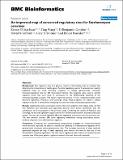| dc.contributor.author | Wang, Ting | |
| dc.contributor.author | Gifford, David K. | |
| dc.contributor.author | Stormo, Gary D. | |
| dc.contributor.author | Fraenkel, Ernest | |
| dc.contributor.author | MacIsaac, Kenzie Daniel | |
| dc.contributor.author | Gordon, D. Benjamin | |
| dc.date.accessioned | 2010-09-29T15:37:39Z | |
| dc.date.available | 2010-09-29T15:37:39Z | |
| dc.date.issued | 2006-03 | |
| dc.date.submitted | 2005-09 | |
| dc.identifier.issn | 1471-2105 | |
| dc.identifier.uri | http://hdl.handle.net/1721.1/58756 | |
| dc.description.abstract | Background: The regulatory map of a genome consists of the binding sites for proteins that determine the transcription of nearby genes. An initial regulatory map for S. cerevisiae was recently published using six motif discovery programs to analyze genome-wide chromatin immunoprecipitation data for 203 transcription factors. The programs were used to identify sequence motifs that were likely to correspond to the DNA-binding specificity of the immunoprecipitated proteins. We report improved versions of two conservation-based motif discovery algorithms, PhyloCon and Converge. Using these programs, we create a refined regulatory map for S. cerevisiae by reanalyzing the same chromatin immunoprecipitation data. Results: Applying the same conservative criteria that were applied in the original study, we find that PhyloCon and Converge each separately discover more known specificities than the combination of all six programs in the previous study. Combining the results of PhyloCon and Converge, we discover significant sequence motifs for 36 transcription factors that were previously missed. The new set of motifs identifies 636 more regulatory interactions than the previous one. The new network contains 28% more regulatory interactions among transcription factors, evidence of greater cross-talk between regulators. Conclusion: Combining two complementary computational strategies for conservation-based motif discovery improves the ability to identify the specificity of transcriptional regulators from genome-wide chromatin immunoprecipitation data. The increased sensitivity of these methods significantly expands the map of yeast regulatory sites without the need to alter any of the thresholds for statistical significance. The new map of regulatory sites reveals a more elaborate and complex view of the yeast genetic regulatory network than was observed previously. | en_US |
| dc.description.sponsorship | Pfizer Inc. | en_US |
| dc.description.sponsorship | National Institute of General Medical Sciences (U.S.) (NRSA award) | en_US |
| dc.description.sponsorship | National Institutes of Health (U.S) ( grant 1R01 HG002668-01 ) | en_US |
| dc.description.sponsorship | National Institutes of Health (U.S) ( grant HG00249 ) | en_US |
| dc.description.sponsorship | National Institutes of Health (U.S) ( training grant in genomic science 2T32HG00045 ) | en_US |
| dc.description.sponsorship | Society of Kauffman Fellows | en_US |
| dc.publisher | BioMed Central Ltd | en_US |
| dc.relation.isversionof | http://dx.doi.org/10.1186/1471-2105-7-113 | en_US |
| dc.rights | Creative Commons Attribution | en_US |
| dc.rights.uri | http://creativecommons.org/licenses/by/2.0 | en_US |
| dc.source | BioMed Central Ltd | en_US |
| dc.title | An improved map of conserved regulatory sites for Saccharomyces cerevisiae | en_US |
| dc.type | Article | en_US |
| dc.identifier.citation | BMC Bioinformatics. 2006 Mar 07;7(1):113 | en_US |
| dc.contributor.department | Massachusetts Institute of Technology. Computer Science and Artificial Intelligence Laboratory | en_US |
| dc.contributor.department | Massachusetts Institute of Technology. Department of Biological Engineering | en_US |
| dc.contributor.department | Massachusetts Institute of Technology. Department of Electrical Engineering and Computer Science | en_US |
| dc.contributor.department | Whitehead Institute for Biomedical Research | en_US |
| dc.contributor.mitauthor | MacIsaac, Kenzie Daniel | |
| dc.contributor.mitauthor | Gordon, D. Benjamin | |
| dc.contributor.mitauthor | Gifford, David K. | |
| dc.contributor.mitauthor | Fraenkel, Ernest | |
| dc.relation.journal | BMC Bioinformatics | en_US |
| dc.eprint.version | Final published version | en_US |
| dc.type.uri | http://purl.org/eprint/type/JournalArticle | en_US |
| eprint.status | http://purl.org/eprint/status/PeerReviewed | en_US |
| dc.date.updated | 2010-09-03T16:23:08Z | |
| dc.language.rfc3066 | en | |
| dc.rights.holder | MacIsaac et al.; licensee BioMed Central Ltd. | |
| dspace.orderedauthors | MacIsaac, Kenzie D; Wang, Ting; Gordon, D Benjamin; Gifford, David K; Stormo, Gary D; Fraenkel, Ernest | en |
| dc.identifier.orcid | https://orcid.org/0000-0001-9249-8181 | |
| dc.identifier.orcid | https://orcid.org/0000-0003-1709-4034 | |
| mit.license | PUBLISHER_CC | en_US |
| mit.metadata.status | Complete | |
